



















The most massive artificial objects to reach space (LEO) or beyond including space stations. Spacecraft may change mass over time such as by use of propellant.
Contents
Currently the heaviest spacecraft is the International Space Station, nearly double Shuttle-Mir's mass in orbit. It began assembly with a first launch in 1998, however it only attained its full weight in the 2020s, due to its modular nature and gradual additions. Its mass can change significantly depending on what modules are added or removed.
During the Shuttle–Mir program between 1994 and 1998, the complex formed by the docking of a visiting Space Shuttle with Mir would temporarily make it the heaviest artificial object in orbit with a combined mass of 242 tonnes (238 long tons ; 267 short tons ) or 242,058 kg (533,647 lb) on STS-74 in a 1995 configuration. [1] [2]



